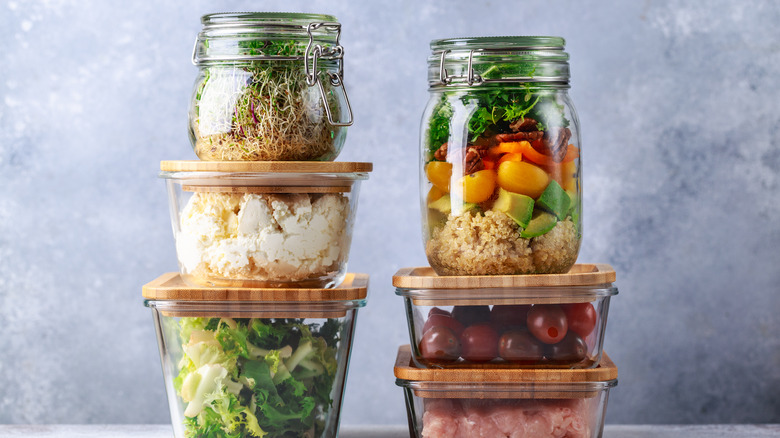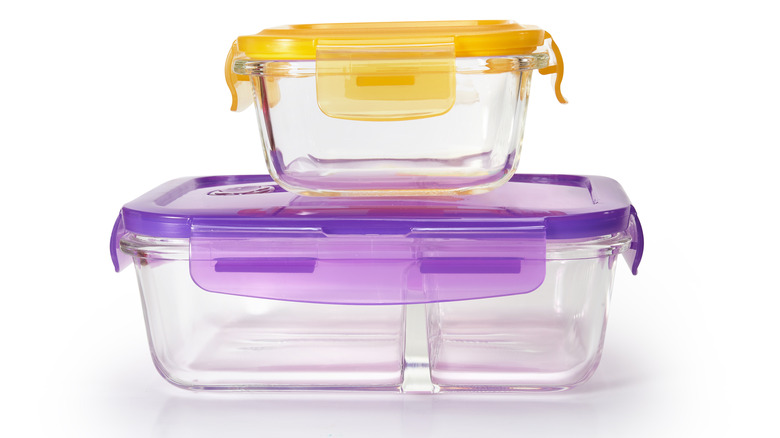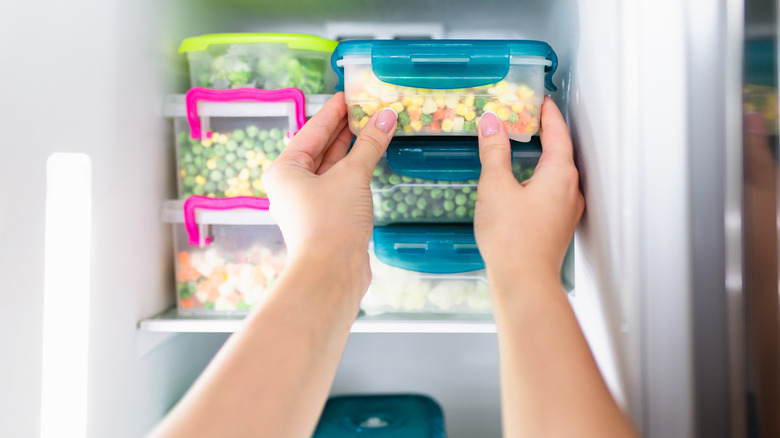The Best Type Of Container To Prevent Freezer Burnt Food
Freezer burn might be one of the most pervasive (and annoying) issues in food storage. This phenomenon occurs when frozen items are damaged, dehydrated, or oxidized by exposure to the dry, cold environment of the freezer. While eating foods with freezer burn does not put you at a risk of foodborne illness, it will certainly ruin the taste and texture of ice cream, fruits and veggies, meat, and more.
If you want to prevent your frozen foods (and your taste buds) from feeling the burn, so to speak, try storing your items in airtight glass containers. Freezer burn is caused by sublimation, a process where ice can evaporate into a gas without melting into water beforehand. This damages the cells in meats and produce, causing discoloration and making them susceptible to moisture loss during cooking. While your frozen chicken breasts or broccoli might turn out dry, ice cream and popsicles usually end up covered in ice crystals that disrupt their smooth texture.
Luckily, sealed glass containers excel at preventing sublimation, due to their airtight lids and material. The sturdy glass and tight seal prevent the moisture content in your frozen goods from escaping, which would eventually dehydrate them and cause those dreaded ice crystals and "off" flavors. With that being said, some glass containers will do a better job than others, so make sure to pick the right kind and wave freezer burn goodbye.
Choose glass containers with thick sides and sealable lids
Not all glass containers are made the same, especially when it comes to durability in the freezer. All glass is susceptible to thermal shock, a condition where sudden temperature changes can cause damage to the material. This is why pouring hot water over an icy car window can make it crack or even shatter, and why sticking a cold glass casserole dish into a hot oven can end in disaster. The same thing can happen when you put a fragile glass container full of hot or even lukewarm food into your freezer.
Thick-walled containers made specifically for food storage are a must-use to avoid accidents. Look for products that are labeled as oven- and freezer-safe. Most of these containers feature heavy, fortified glass that won't shatter under the frigid temperatures of your freezer. No glass containers are immune to thermal shock, however, so you still want to use caution. Let your food cool before putting it in cold storage, and let your cold glass container and its contents thaw if you're planning to transfer them right into the oven to cook (which you can do, so long as you're careful!).
Mason jars are another sealable glass container that can withstand the freezer without much trouble. However, don't use shouldered mason jars — the kind that round out at the top and bottom — in the freezer. Their curvier shape makes them more prone to thermal shock than their straight-sided counterparts.
Other containers that help prevent freezer burn
If all this talk about thermal shock has you a bit scared, sealable plastic containers are another great way to store foods in the freezer. Much like glass containers, these items efficiently seal in the moisture content of your foods, and can withstand icy conditions. They are also not as dangerous when they shatter, making them much easier to clean up if they break in the freezer.
Plastics, however, are more prone to staining and absorbing the odors of the foods. Greasy, pungent, or acidic sauces such as pasta sauce are usually the leading culprits of weird colors or odors lingering on your plastic containers, so try to store these types of foods in glass, instead.
Sealable plastic bags are another great way to store groceries in the freezer, and can save you a lot of space. After putting food inside, you can press the air out of freezer bags and lay them flat. Searching for sturdy, freezer-stable bags should be the move here, as they are not as prone to ripping and can even be reused a few times. In a pinch, wrapping food in aluminum foil can seal in moisture while shutting out dry freezer air, but it helps to add an extra layer of plastic wrap underneath the foil, for the best chance at preventing freezer burn.



